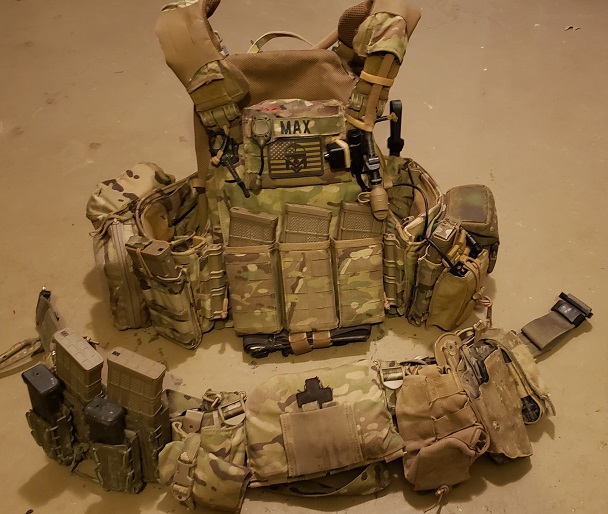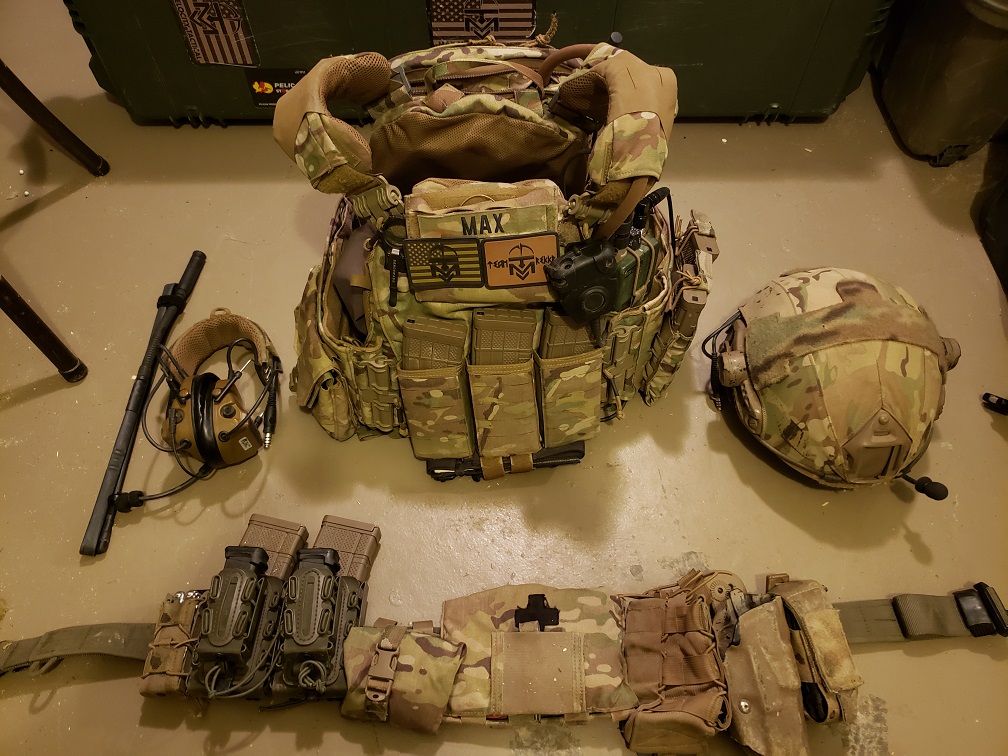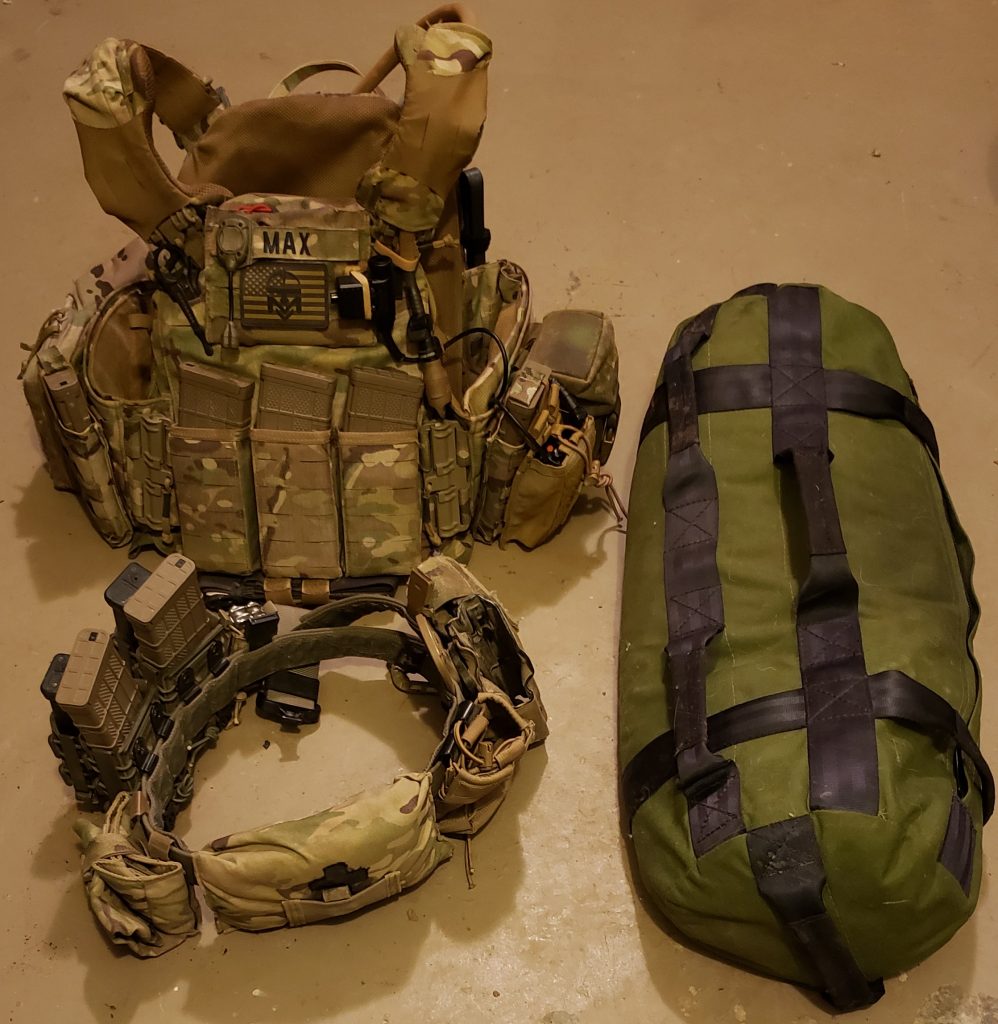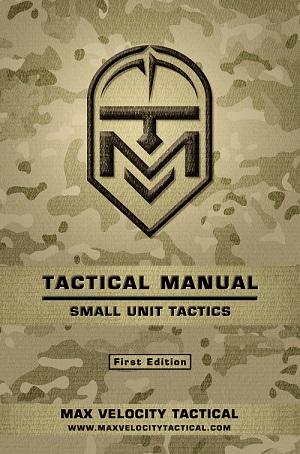Gear: The MVT Lite Fight Concept
This is a follow-up post to:
The Practical Application of Tactical Gear, Load & Weight Considerations
And builds on this video post.
Current gear:

There is not a huge difference between the gear originally displayed when I first posted this concept, merely a different rifle and Lite Hydration Pack, plus I have added the helmet to the mix for purposes to be explained below. This illustrates the point that this post is not about SPECIFIC BRANDS of gear, but rather the MVT Lite Fight concept that I have been advocating in these various blog posts.
Not so long ago:

In this post, I will be making some detailed comments. This post is specifically about putting all this gear together for wear during combat conditions, and will not cover the ground in detail about how you will escalate, or combine, or choose items of gear to escalate your everyday carry as a response to increased threats. That was covered in detail in the linked posts above. This post is about putting this MVT Lite Fight concept together when the threat is extant, we are conducting combat operations, the hammer already dropped, the balloon went, up, and there are possibly bad guys in the wire. You are conducting active home base defense / ground domination activity. This does not mean you lose all flexibility, and you still have the option of combining or dropping items depending on the mission, terrain, duration, distance and weather.
The MVT Lite Fight Concept consists of the following:
- Lite Hydration Pack (LHP).
- Plate Carrier (PC).
- (Helmet).
- Lite Battle Belt (LBB).
- Rifle
All this gear put together should be both the maximum, and the minimum, that you would expect to carry on any operation away from your home where there is any chance of contact with the enemy. This means any operation ‘out of sight’ of your home base, and any patrol where you are not literally within a 100 yards or so of that home base. If you are at home base, then you can choose what you will wear i.e. what elements of the system. There is nuance and reality to add to this, which I will discuss below. Please remember the premise: we are now in ‘combat conditions.’ However, reality will play a role, and you will have to adjust your profile depending on the exact specifics of the mission you are on – bartering at the local farmers marker, for example, will likely see a deescalation of this combat profile and you will leave gear in the vehicles.
Yes, you will look like a soldier in this gear. It does not have to be multicam, but the bottom line is that if you are conducting combat operations, you need to be equipped as a light infantryman.
One of the main drives of this concept is to carry enough to be effective, but not so much that you become ineffective. Refer to the previous posts for discussion of second line ammunition and ration / water logistical scales on support vehicles. There is a balance of strength and fitness versus weight, and depending on your limitations you may have to adapt this concept to suit. That will be discussed below in the detail. You do however have to do whatever physical conditioning you are able to handle, if you are considering a light infantry combat role. If you are prevented from carrying the minimum of this gear by age or physical condition, then you should look to a support role, situated out of the home base where you can contribute to security by standing watch and being part of the static defense team. You are likely to be able to primarily contribute in areas other than security in a considerable manner, depending on your skills and attributes.
For those who are equipped in this manner they need to be physically conditioned to be able to maneuver under enemy fire. They must be trained and rehearsed in team tactics. You cannot run this type of thing with a pick-up team, if you want to stand any chance at all. This is all a balance between firepower, mobility, and protection. There is no perfect solution.
BALANCE:
FIREPOWER – PROTECTION – MOBILITY
The Detail:
(1) Lite Hydration Pack (LHP):
- This should be a small pack that includes a water bladder (2 – 3 Liters). It should not exceed more than 15 liters of capacity for the pack. Any more than that and your gear total will make you unable to maneuver effectively under effective enemy fire.
- You must resist the temptation to keep packing this, and going bigger with this pack. It will be frustrating, and you will want to put more in, just in case. Just put it on and consider if, with this gear load, you can maneuver under enemy fire. That is your benchmark.
- Do not forget the need for some sort of logistic chain or support network, either at the home base or forward mounted in vehicles.
- This is not a ‘ruck’ and you are not going overnight. What missions are you planning? This is merely an expanded hydration pack with room for some essentials. You should be able to go for 24 hours in this pack; mostly you will be out for a few hours local patrolling. In the summer, you will be hot and sweaty. In the winter, you will start the patrol cold and have basic snivel / rain gear for survival if you go static.
- If you are moving in vehicles, this pack becomes your grab bag.
- If you get into contact, you will need ammo resupply and potentially casualty evacuation. A Quick Reaction Force (QRF) equipped with some sort of vehicle, and communications with them, will be required.
- Thoughts on some options for what you should include in the pack (these can be elsewhere on your gear):
- Hydration bladder
- Water purification tabs / straw / pump or means to fill / drink more water than you have in the bladder.
- Basic weapon cleaning kit / lube (SLIP 2000) / spares – including rod to remove stuck cases.
- Emergency energy bars
- Packed meal / energy – for duration of patrol.
- Basic gear for layering – ‘snivel gear’ – you will be able to fit, for example, a rain jacket in there. Cap / gloves.
- Night vision gear *Note* see more on this below.
- FLIR Thermal – this can fit in the pack, or be mounted to hand on your gear.
- Batteries – radio / night vision
- Magazines – there are single magazines in pouches each side of the pictured pack, total 2.
- Basic ‘boo-boo’ first aid kit (very small pouch), with any meds and anti-inflammatory (i.e. Aleve/ naproxin).
(2) Plate Carrier. There are a number of notes on the Plate carrier (PC):
- It is highly recommended to wear ballistic plates in a kinetic combat environment.
- You should invest in ceramic/hybrid ‘Level 3 plus’ lightweight plates. This is an investment in mobility while retaining protection.
- If you cannot maneuver with the weight of the plates and the rest of your gear, then do not use them. This is a function of your conditioning level. You have to do the PT to be able to wear the plates.
- Be careful when rigging your PC to ensure that you do not go overboard with the weight.
- You can replace the PC with a chest rig. This is a personal decision based on your purchasing criteria and physical conditioning relative to ballistic plates.
- You can wear a chest rig over a slick PC, using the chest rig straps, or you can use a PC attachment kit to mount a chest rig directly to the slick PC. These are all mounting options which give you flexibility, and allow you the decision on a case by case basis to wear the PC, or not.
- There is no perfect solution to the balance of weight versus conditioning versus operational capability. You have to carry some gear to be effective on the ground as a dismounted infantryman, but you cannot carry too much or it will render you ineffective:
BALANCE:
FIREPOWER – PROTECTION – MOBILITY
Ballistic Plates:
- There is a persistent tomfoolery about steel plates. These are heavy, suffer badly from spalling (ever shot a steel target – you are wearing one), you cannot navigate while wearing them (magnetic compass) and in the winter it would be like wearing a refrigerator.
- Ceramic / hybrid plates are criticized for needing a little more care, like not throwing them off the back of your truck lest they crack (which in itself does not make them ineffective) and for not being as ‘multi-hit’ as steel. I don’t throw my optics or night vision or radios off the back of my truck either.
- Ceramic / hybrid plates are in fact multi-hit and due to the weight savings are a considerable investment in protection and mobility versus steel.
- The idea that steel will take so many more hits is a silliness rooted in lack of combat experience. The idea of ballistic plates is to cover vital organs in the event that you are unfortunate enough to take hits. There are plenty of places outside of the plate coverage where you can also get hit and it will wound or kill you. Are you expecting to survive multiple contacts with rounds pinging off your steel plates? If you are lucky enough to defeat a round due to wearing ceramic plates, it does not make the plate suddenly ineffective, and you should consider yourself lucky to walk away. In terms of multiple hits on and near to the plate, if the plate allows you to survive wounded, but not killed, consider yourself lucky.
- You will make your own decisions regarding ballistic plates. Given the whole thrust of this MVT Lite Fight concept, I do not recommend steel plates as an option.
- One of the reasons to keep a PC with mags on the front is part of the gear concept on the ramp up to full combat conditions – in terms of home invasion or similar scenario you can quickly put on the PC, which will give you ammo to feed your rifle and protection in a CQB environment. This also applies to emergency ‘stand-to’ in the combat environment, where you roll out of bed, don the PC, and grab your rifle to defend the home base. Too much gear and strappage to deal with will slow you down.
The Ergonomics of Gear Wear:
- The Lite Battle Belt should be rigged so that it is minimalist and does not prevent you from sitting in a chair or vehicle. Large ‘ALICE’ style LBE rigs are a mistake and will impede you, both for vehicle and CQB environments.
- Having mags chest mounted on a chest rig or PC, such that you only have one layer of mags and the whole piece of gear is not too deep, is preferable for a couple of reasons:
- This is in fact easier to reload from the prone, contrary to another myth out there, than it is with hip mounted magazines.
- A single layer of magazines on your front will not impede crawling.
- Magazines / gear chest mounted lays within the triangle of your standing shooting position, within your arms carrying your rifle. This means that when in the standing position, they effectively take up no space (only dead space). A large LBE-type battle belt with large admin pouches will hinder you in a vehicle, home base, or CQB environment.
- The MVT Lite Fight Concept is optimized for moving in and out of vehicles and through doorways in a home base or CQB environment. On the CQBC classes students soon learn the disadvantages of large belt mounted pouches, even ‘two deep’ magazine pouches on the hips, when they get hung up in doorways.
- Stay away from huge under-armpit pouches on the PC or Chest Rig.
- It is an issue attaching your Lite Hydration Pack to the back of your PC, or alternatively have pouches on the back of your PC. You cannot access them. You need to be able to take the pack off to get at items within it. You cannot fill, for example, your hydration bladder without taking off your PC or chest rig, if it is attached directly to it. You lose flexibility. I am currently doing this – it is a balance of less strappage vs. convenience of getting into the backpack.
- You should only have the shoulder straps of the PC/chest rig plus the straps of the hydration pack, to deal with. This is one reason to attach the chest rig directly to the PC, or to simply have mag pouches on the PC as in the photos here. Adding Battle Belt suspenders, plus a PC and a chest rig mounted by its own straps, plus the pack straps soon gets you into strap hell. If you are not wearing the PC, then you should only have the chest rig straps plus the pack straps to deal with: maximum two sets of straps over the shoulders.
(3) Helmet:
- Wearing a ballistic helmet definitely puts your profile into that of a light infantryman. There are however plenty of good reasons to be wearing a helmet in a kinetic environment where you are conducting combat operations. No one wants to wear it of course, because it is uncomfortable, but then again we are mostly playing right now, wearing our ball caps and boonie hats. I personally know someone who took a round to the side of the helmet, which stopped it, and he survived, although with a TBI, which he recovered from.
- I know most of the readership here does not plan on wearing a ballistic helmet.
- However, many plan to use a helmet for the mounting of a PVS14 for night vision capability. If you plan to do that, then use a Crye Nightcap instead which will not give you the storage and extra weight problems of carrying the helmet strapped to your LHP during the day.
- If you do not like the Nightcap, and want something more solid to mount night vision to, then consider a bump helmet which is lighter but has no ballistic protection capability.
- If you carry a ballistic helmet for night vision, and consider it worthwhile protection, then wear it during the day also!
- If you utilize a system for attaching Peltors (hearing protection / enhancement) to your helmet, that can be very useful. If you utilize a civilian (Baofeng-type radio (i.e. GT-3WP) then you can visit Disco32 for the correct push to talk and other ancillaries to make the radio work well this this system.
(4) Lite Battle Belt (LBB):
- This has been covered in detail in the linked previous posts including discussion of how it fits within the overall picture both currently in ‘normal times’ and once you reach combat conditions and tactical operations.
- The idea of the LBB is to give you a comfortable basic load for handgun and rifle that compliments the rest of your gear and also allows you a day to day piece of equipment that carries that basic load. You have the handgun on you and the rifle close at hand.
- If you are using radios, and depending on your response to the rest of this article and what you plan on taking from this MVT Gear Concept, you may want to mount the radio on the LBB and run an earpiece/mike up from it – if you are unsure of what options you will wear at any one time with the PC/Chest Rig then at least this way you have the radio on you at all times. Bottom line, consider where you will mount your radio depending on what gear you decide to put on.
- I have a bottle pouch on the LBB for the same reason, for convenience on the ranges during class – I have something to hydrate from even when just wearing the LBB.
- The IFAK is also on the belt because I plan on wearing the LBB at all times as the basic item of gear I will build up into the other items from. This means I have the IFAK on me.
- The folded dump pouch can easily be replaced with a radio pouch if you wish to run comms gear on the LBB. Given that during combat reloads magazines will mostly get dumped on the ground, I am not concerned about the dump pouch and it can go if needed. Empty mags can also go in cargo pockets if there is time.
(5) Rifle:
- I use a rigged-out Colt 6920 OEM2.
- Ensure you choose a reliable brand of carbine for combat operations. There is discussion and recommendation on this on the MVT Forum.
- Ensure that if you have a low profile gas block, that it is pinned. Stay away from the ‘frankenguns.’ Also, be aware that many popular manufacturers make rifles that are great for light use, plinking, 3-gunning etc, but use a set screw with loctite rather than pinning the gas block. When run hard under combat conditions in training or operations, this will fail and you will find yourself with a bolt gun.
- 5.56 is ideal as a combat carbine. The AR is the perfect ergonomic rifle. The only time I would recommend a heavier caliber would be to add .308/7.62 to a patrol in the form of a designated marksman buddy pair. The intent here is to make up for the absence of volume of fire from belt-fed weapons with precision from a .308 rifle. An AR10, rather than a bolt gun, would be ideal, because it is still capable of combat rates of fire.



